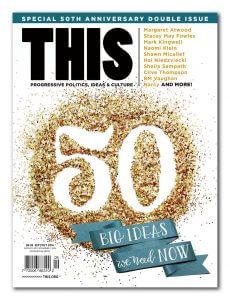Canada’s census must include a third gender category
About 350,000 Canadians identify as non-binary—including me. Why can't we accurately report our gender to the government?
andrea bennett@akkabah
 For our special 50th anniversary issue, Canada’s brightest, boldest, and most rebellious thinkers, doers, and creators share their best big ideas. Through ideas macro and micro, radical and everyday, we present 50 essays, think pieces, and calls to action. Picture: plans for sustainable food systems, radical legislation, revolutionary health care, a greener planet, Indigenous self-government, vibrant cities, safe spaces, peaceful collaboration, and more—we encouraged our writers to dream big, to hope, and to courageously share their ideas and wish lists for our collective better future. Here’s to another 50 years!
For our special 50th anniversary issue, Canada’s brightest, boldest, and most rebellious thinkers, doers, and creators share their best big ideas. Through ideas macro and micro, radical and everyday, we present 50 essays, think pieces, and calls to action. Picture: plans for sustainable food systems, radical legislation, revolutionary health care, a greener planet, Indigenous self-government, vibrant cities, safe spaces, peaceful collaboration, and more—we encouraged our writers to dream big, to hope, and to courageously share their ideas and wish lists for our collective better future. Here’s to another 50 years!
In May, I followed a BuzzFeed community post by Sabine Grutter, a Montreal-based transmasculine researcher, on how to respond to the Canadian census as a non-binary trans or intersex person. Grutter suggested we opt out of choosing M or F, ignore the reductive checkboxes, and leave detailed comments instead. While I appreciated this workaround, I was also irked that, at some point in the data interpretation process, I’d be funneled right back into a checkbox marked “M” or “F”—while StatsCan provided a way to avoid the binary in the questionnaire, its data collection would still rely on it.
I’m one of an estimated 350,000 Canadians who identify as non-binary. For me, this means that I feel most comfortable between genders, with some masculine and some feminine traits. It also means I don’t feel comfortable with gendered terms. I would like to set fire to honorifics and sidestep over being called Ms., or, worse, Miss or Mrs., ever again; while I’m married, I experience an internal allergic reaction every time someone refers to me as my partner’s “wife.”
The fact that the census doesn’t accurately collect gender information is completely ridiculous—why run a census if it doesn’t capture demographic data correctly? Moreover, in an email interview William (Doré) Garland of StatsCan referred to the workaround as a process that “assist[ed] transgender or non-binary people in responding to the questionnaire”— a statement that makes it seem as though we need help, when the truth is that the questionnaire is only difficult for us because it doesn’t provide the options we need.
StatsCan is set to release a document based on gender data-related comments, and Garland asserted that the StatsCan will run “extensive public consultations” about how it should treat gender in the 2021 census. This is all well and good, but it seems pretty clear to me: the census needs to contain, at the very least, a third gender category, or we’ll continue to erase people who identify as non-binary trans, non-binary, genderqueer, two-spirit, intersex and a-gender. If we’re lucky, this third category will contain a secondary dropdown to further specify— wouldn’t it be interesting to see how identifications evolve over time?—as well as an “other” box, just in case we missed someone. Our demographic data helps us to create policy and carry out important and meaningful research, and we cannot do that until our government acknowledges that gender doesn’t fit neatly into two checkboxes.
Illustration by Matthew Daley
andrea bennett is a National Magazine Award-winning writer and an associate editor at Maisonneuve magazine.